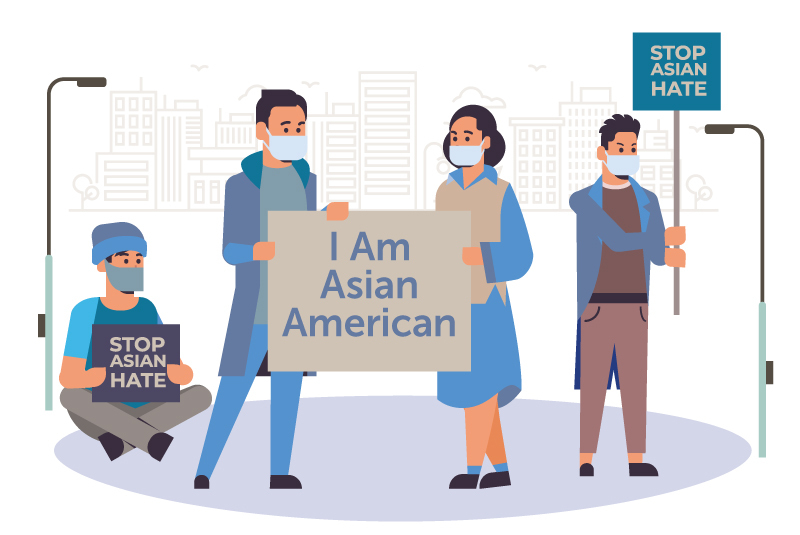Helping your kids understand and cope with anti-Asian racism

Over the past year, there has been an alarming increase in anti-Asian sentiment and discrimination in the United States. The advocacy and hate reporting group Stop AAPI (Asian American Pacific Islander) Hate reports more than 6,600 hate incidents — including harassment, shunning, and physical attacks — since the start of the COVID-19 pandemic in March 2020. Kids are also being targeted more frequently: as of September 2020, one in four Asian American youths reported experiencing racist bullying. And many experts believe this is just the tip of the iceberg.
Break the silence
“Research has found that Asian Americans are among the least likely to report hate incidents,” says Erica Lee, a psychologist in the Department of Psychiatry at Boston Children’s Hospital. “There are various reasons they remain silent, including the high value many Asian cultures place on maintaining social harmony. They may not speak out because they don’t want to bring more attention to themselves, burden their loved ones, or report to law enforcement.” These factors can make it harder for Asian Americans to advocate for themselves when they experience discrimination or racism.
Lee says this makes it important for parents to address the issue of anti-Asian hate and racism with their children. “Kids take their cues from parents. When parents are silent about racism it can make kids feel even more scared, alone and confused. We are not ‘shielding’ them by ignoring these issues, because they will fill in the gaps.”
Empower kids to speak up
Lee says Asian American parents and kids may also feel guilty about naming the racism they experience when they see more extreme or frequent racism occurring against those from other backgrounds. “Asian American kids may feel like they don’t have the right to be upset, because there are ‘worse’ things happening to others. But as parents, we need to try to teach them that their feelings and safety matter too, and it’s okay to speak up.”
We need to give our kids permission to talk about racism. If we’re not speaking out about it and not giving our children agency to speak out about it, then we’re not acknowledging racism exists.”
Erica Lee
She says to let your kids know that anti-Asian violence — and racism of any kind — is unequivocally wrong. “Tell them it’s against your values and is never okay,” says Lee. “And if they hear it or see it, they should tell an adult they trust and try to help. A lot of kids feel stuck or helpless in these situations, so it helps to have a plan if it happens to them or their friends.”
You can even walk kids through what they might do or say if they see someone being treated unfairly. “Kids can say, ‘that’s wrong’ or ‘that’s hurtful,’” says Lee. “Teach them use their voice to be an upstander instead of a bystander. And then, as they get older, they will feel more comfortable speaking up when they encounter racism.”
Talk about racism with your kids
Lee says it’s crucial to give children space to talk about racism, and to process their feelings about hateful words or actions they may see or experience.
“We need to give our kids permission to talk about racism. If we’re not speaking out about it and not giving our children agency to speak out about it, then we’re not acknowledging racism exists,” says Lee.
Lee says parents may not be aware if their kids have witnessed anti-Asian incidents or remarks. “Ask your kids if there are things they have seen or heard out in the neighborhood or on the playground, and how they’re feeling about it,” says Lee. A lot of times, kids don’t understand certain terms and many not bring them up unless they are asked. “Parents are an important conduit in helping kids understand the world and respond to difficult experiences. Their openness and validation can make all the difference.”
She acknowledges that racism isn’t an easy topic and parents may not have all the answers. “These conversations can be uncomfortable and scary for many parents. Try to think of them as opportunities for honest and meaningful moments with your kids. It’s okay to say, ‘I don’t understand this either, but here’s what I’m feeling and thinking, and let’s figure this out together.’”
If you need more help, Lee suggests a helpful guide from William James College that offers tips especially geared toward parents of Asian American children. It’s available in several languages.
Support your child’s ethnic identity
For all children, but especially children who identify as BIPOC (Black, Indigenous, and people of color), having a strong racial and ethnic identity is crucial to building resilience and good self-esteem. It also helps them cope when they experience situations of racial stereotyping or racism.
It’s really important that kids have a solid sense of who they are, and that they feel positively about their cultural heritage.”
Erica Lee
Lee says that for Asian American youth, it’s important to recognize the power of the “model minority” myth, which stereotypes Asian Americans as a uniformly agreeable, compliant, hard-working, and successful group. “The model minority myth erases the diversity of the Asian American community, ignores the struggles many Asian Americans face, and contributes to anti-Asian resentment and hate,” says Lee. “It can also make Asian American kids reluctant to ask for help when they are struggling.”
She suggests that Asian American parents help their kids develop a strong racial and ethnic identity by sharing positive messages about their cultural history, tradition and values. “It’s really important that kids have a solid sense of who they are, and that they feel positively about their cultural heritage,” says Lee. “That becomes a powerful buffer against inaccurate generalizations like the model minority myth.”
Find similarities and celebrate differences
Children as young as 3 months old notice differences in physical appearance, and by preschool, they can categorize people and make decisions based on physical characteristics. So it’s important for parents to guide kids in understanding that differences do exist, and that it’s what makes people unique. “When parents ignore difference, kids learn that being different is bad or undesirable, instead of interesting and valuable,” says Lee.
Parents can help by shining a positive light on differences. For example, if your child notices someone has a different skin tone, hair, or facial features, make it a teaching moment. “Instead of silencing your child if you’re feeling embarrassed, you can respond by saying, ‘Yes, and isn’t it wonderful that there are so many different kinds of people in the world?’”
Lee says it’s also important to highlight similarities to reduce stereotyping. “Use books or movies to show your kids there are role models and heroes from all different backgrounds. Explain that even though some families might eat different foods or have different holiday traditions than your own, they can also enjoy the same hobbies, play the same sports, or watch the same TV shows. Let them know that people who seem different than them share the same values, such as empathy, curiosity, or fun.”
Get involved
For many parents, it can also help to feel like you’re part of broader community taking a stand against anti-Asian hate. “There are lots of ways to express solidarity or alliance with the Asian American community. Families may want to put up a sign, join a protest, get involved in a community organization or advocacy group, or lobby members of Congress,” says Lee. “Or you can get together with other families in your community to make a statement or support those who are vulnerable or hurting. There are lots of ways to take action, and the steps you take as a family can empower your kids to become change agents themselves.”
Read more on racism and the Office of Health Equity and Inclusion at Boston Children’s.
Related Posts :
-

Help your child manage anxiety about school violence
With news of school shootings and other violence often reaching children, parents sometimes grapple with how to help their child ...
-

Making pediatric health equity research truly equitable: An EDI review process
A burgeoning number of studies are examining pediatric health equity, diversity, and inclusion (EDI). But if not done right, health ...
-

Firearm suicides in children and youth: A state-by-state look
At a time when mental health problems are skyrocketing, a new study provides one of the most comprehensive state-by-state accountings ...
-

Reversing the trend: Easing the mental health boarding crisis in emergency rooms
Anxiety, depression, and suicide attempts have been rising over the past decade, especially among teens, often landing them in emergency ...





